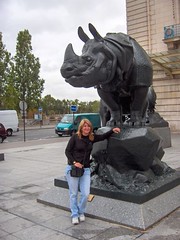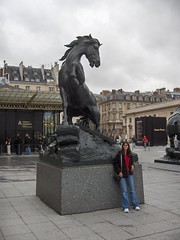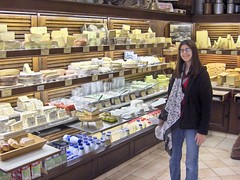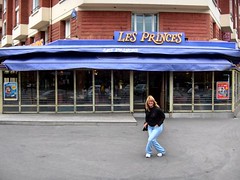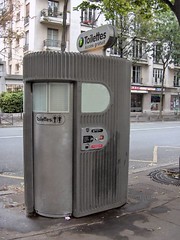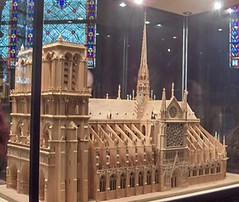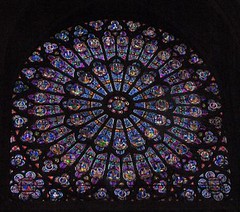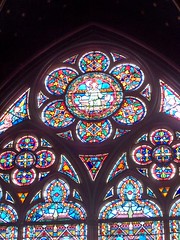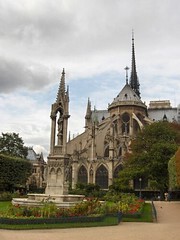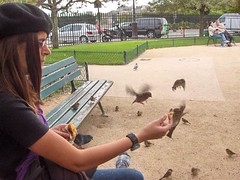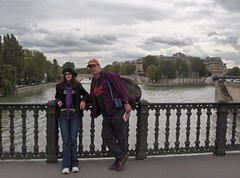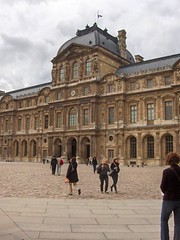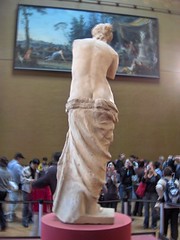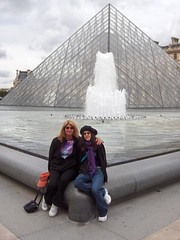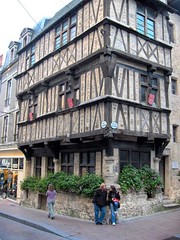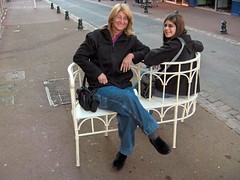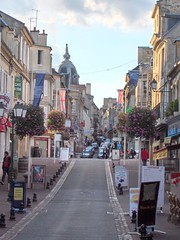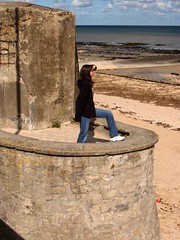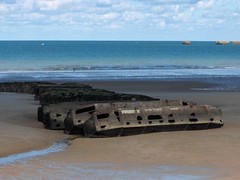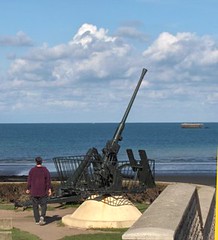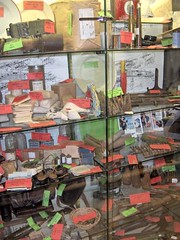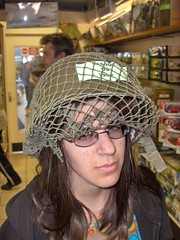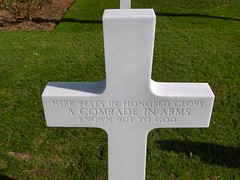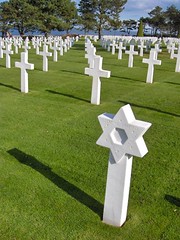Our first stop on our last tourism visit to Paris was the Musee d’Orsee. This museum has an impressive collection of Impressionist masterpieces, and an enormous collection of sculptures.
I was amazed at how close we could get to some of the most famous paintings in the world, and that we were allowed to photograph them, which we were forbidden to do in most parts of the Louvre.
This particular museum seems obsessed with clocks. There are few places where you cannot see at least one enormous clock. The one shown below is in the museum café. It's almost as though the museum designers want to emphasize the passage of time for the visitors, while attempting to stop it completely for the artifacts contained within the walls. | 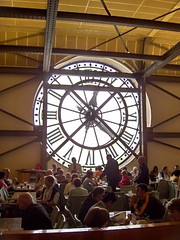 |
I was completely charmed by this Monet painting of a lemon, which is approximately life size. I wondered what compelled him to invest the time to paint this image. Also, who is the person at the museum responsible for the selection of frames? The one on this lemon picture is far too ornate and bulky for such a tiny, simple image. It’s almost as though the curator wanted to emphasize the importance of the artist, ignoring the fact that it’s a goddamn picture of a lemon.
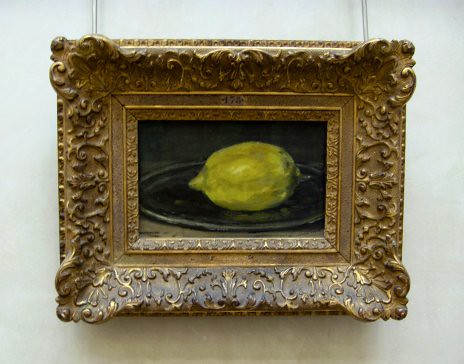 Here I am standing in front of one of Monet’s famous haystack paintings. He did a whole series of these, and they’re quite lovely. I was suffering from a nagging, phlegmatic cough the entire time, so I’m afraid I left a fine spray of bronchial mucus on some of the great Impressionist works of the early 20th century. Some poor conservator will have to clean it off someday.
Here I am standing in front of one of Monet’s famous haystack paintings. He did a whole series of these, and they’re quite lovely. I was suffering from a nagging, phlegmatic cough the entire time, so I’m afraid I left a fine spray of bronchial mucus on some of the great Impressionist works of the early 20th century. Some poor conservator will have to clean it off someday.
 My daughter reached art saturation fairly quickly, and found a place to sit where she could read a book, surrounded by beauty she was unable to appreciate. Note the large clock on the far end of the sculpture hall.
My daughter reached art saturation fairly quickly, and found a place to sit where she could read a book, surrounded by beauty she was unable to appreciate. Note the large clock on the far end of the sculpture hall.
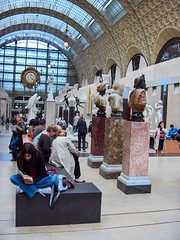 After the museum, we went out for coffee. In Paris, you can order coffee in many forms. We had café noisette, café Viennois, and cappuccino.
After the museum, we went out for coffee. In Paris, you can order coffee in many forms. We had café noisette, café Viennois, and cappuccino. 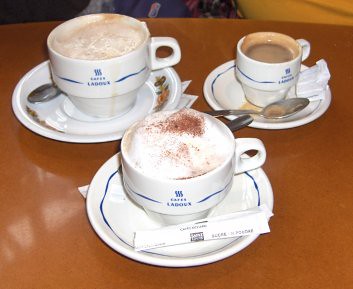 Later, we strolled through the city, and I pointed out a Boucherie Chevaline (a butcher specializing in horsemeat) to my daughter, who was totally grossed out. We visited a Fromagere, a shop selling nothing but cheeses. My daughter was in heaven, and bought a giant lump of Mimolette to bring home.
Later, we strolled through the city, and I pointed out a Boucherie Chevaline (a butcher specializing in horsemeat) to my daughter, who was totally grossed out. We visited a Fromagere, a shop selling nothing but cheeses. My daughter was in heaven, and bought a giant lump of Mimolette to bring home.
Well, that about sums it up for this trip to France. I would like to thank the French people, who were unfailingly gracious hosts. In particular, I would like to thank the proprietor of Les Princes café, which was located near the parking garage. We used the bathroom there every day on arrival and every evening on departure from the city. Merci, mon ami. I would also like to thank the mayor of the city of Paris for installing the cool space toilets in high-tourism areas. These little pods would open at the press of a button, enabling you to do your business, then they would clean and sanitize themselves before admitting another desperate tourist. Formidable!
On our second visit to Paris, we took the Metro to Ile de Cite, where Notre Dame is located. Notre Dame is not the oldest or largest cathedral in France, but thanks to Victor Hugo it is certainly the most famous. There’s a massive restoration project underway, and the front façade of the cathedral has been returned to its original grandeur.
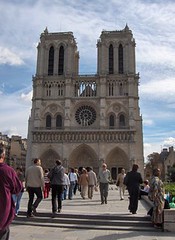 | 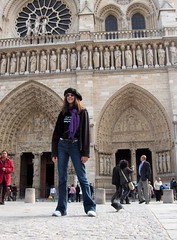 |
The square outside is bustling with tourists, students and artists. By now, my daughter had adopted a very French style, purchasing a beret and a foulard. She told me that she had been watching French women very closely to see exactly how they knotted their scarves so that she could do it just right.
Inside the cathedral, I tried to explain to my daughter how these buildings were constructed entirely of stone, how the stained glass windows are structural units, how the flying buttresses keep the walls from falling outward, but I think it went over her head. In one of the side chapels, there is a nice model of the cathedral, showing the buttresses. I took my daughter outside and showed her the real thing.The stained glass is quite impressive, especially in terms of scale. Some of the rose windows are so huge that I am unable to imagine how they were created.
We went outside to a little park behind the cathedral and ate some lunch. My daughter had way too much fun feeding the sparrows, which annoyed my wife and I because we have sparrows in the United States. The street that runs alongside the cathedral is full of souvenir shops, and we noticed that the shop nearest the entrance to Notre Dame has the highest prices. The prices are lower at the one next door, and so on. The one furthest from the entrance is the cheapest. It’s fascinating that you only had to walk a block to save as much as 50% on this stuff.Later, we took a walk across the Seine and headed over to the Louvre. I had forgotten how massive the Louvre is. It’s an enormous building, and we walked forever along its outer walls looking for the entrance. It’s so big, the cops wear roller blades.
Eventually, we found the entrance. We had purchased tickets online before we left, so getting in was a breeze. We quickly visited the major attractions: Winged Victory, the Venus de Milo and the Mona Lisa, which is displayed behind a sheet of glass that could stop a bazooka shell. I was able to walk completely around the Venus de Milo, and discovered something I never knew about this famous statue: You can see her butt crack.
Once we left the Louvre, we wandered around in Paris for awhile, admiring the architecture.
 We wound up in the Les Halles district, and decided to have a nice meal. Unfortunately, there are lots of tourist restaurants in Les Halles, and it’s hard to distinguish between a good restaurant and a bad one.
We wound up in the Les Halles district, and decided to have a nice meal. Unfortunately, there are lots of tourist restaurants in Les Halles, and it’s hard to distinguish between a good restaurant and a bad one.
We picked one at random and were seated immediately. We noticed that the restaurant was only about 1/4 full, even though it was 6:00 pm. We didn’t know if this meant that the restaurant sucked, or if Parisians eat late.
Years ago, my daughter had tried escargot and claimed to like it. So she ordered it again as an appetizer and took a bite. As it turned out, her tastes had changed, so I wound up eating the other 5 and a half snails.
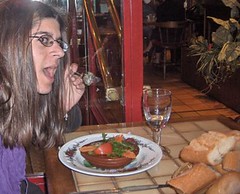 |  |
My wife had a delicious tureen of French Onion soup, served with a spoon the size of a shovel. When our main course arrived, we were all in fine spirits, laughing and kidding around. My wife had ordered a steak of some kind. It was tough and gristly, and she was horribly disappointed. The mood at our table turned sour and I was amazed at how fragile good times can be. It put a damper on our evening, so instead of hanging around to see Paris at night, we headed home in rush hour traffic.
So my advice is, if you’re ever in Paris, stick with the soup.
During one of our shopping excursions, we took my daughter into a French comic book store. These differ from American comic book stores, because in France, comics are treated as an art form, and are printed primarily as graphic novels. The paper, printing and binding are all top quality, and my daughter was very impressed. However, she didn’t want to buy any books, because they were all in French.
There’s a small town in Normandy where one of the most precious artifacts in the world is kept on display. It’s the Bayeux Tapestry, which documents the events surrounding the Battle of Hastings, where William the Conqueror of France invaded England in 1066. It ranks up there with the Rosetta Stone, the Dead Sea Scrolls and Samuel Pepys’ diary in terms of historical significance. I’ve been hearing about it since high school.
The tapestry was intended to be displayed in the nave of the Bayeux Cathedral, and was completed around 1077. It’s made of linen, and it’s nearly a thousand years old. Today it’s kept in controlled conditions in a library adjacent to the cathedral. It’s a lengthy story, illustrated by embroidery, in one continuous strip, 230 feet long by 20 inches high. I convinced my daughter that it would be interesting, because it’s the world’s first graphic novel. As you walk around the town of Bayeux, you see little brass markers on the sidewalk, which lead you to the tapestry. The symbol on the marker is a stylized tree, used in the tapestry to separate the “frames” of the story.
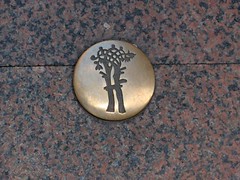 When you enter the display area, a reproduction of the tapestry winds around in a serpentine path, which all of the visitors follow in a shuffling walk. Information about the period, the symbols, the images and the story is presented. It’s tedious reading, so we ducked out and went into the theater where a film provided a much better summation of the story. Basically, it involves the story of Harold (an English Earl) who is captured and held for ransom by a French Count while on a diplomatic visit to France. William, the illegitimate son of the Duke of Normandy arranges for his release, and the two become fast friends. Because the King of England has no heir, Harold promises William that if he is named successor to the English throne, he will step aside and name William as the king. Unfortunately, he breaks his vow, and is crowned King of England during an appearance by Halley’s comet.
When you enter the display area, a reproduction of the tapestry winds around in a serpentine path, which all of the visitors follow in a shuffling walk. Information about the period, the symbols, the images and the story is presented. It’s tedious reading, so we ducked out and went into the theater where a film provided a much better summation of the story. Basically, it involves the story of Harold (an English Earl) who is captured and held for ransom by a French Count while on a diplomatic visit to France. William, the illegitimate son of the Duke of Normandy arranges for his release, and the two become fast friends. Because the King of England has no heir, Harold promises William that if he is named successor to the English throne, he will step aside and name William as the king. Unfortunately, he breaks his vow, and is crowned King of England during an appearance by Halley’s comet.
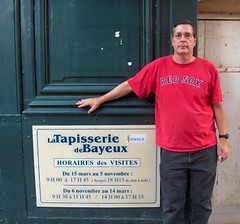 William, outraged by this betrayal, built a fleet of ships, crossed the channel and conquered England in 1066. Harold was killed in the battle. This is the last time in history that England was successfully invaded.
William, outraged by this betrayal, built a fleet of ships, crossed the channel and conquered England in 1066. Harold was killed in the battle. This is the last time in history that England was successfully invaded.
Once the film finished, we went in to view the actual tapestry. As a historical record, the tapestry is invaluable and compelling. As an example of decorative embroidery, it is horribly disappointing. I guess I was expecting something of stunning beauty. Instead, it looks cartoonish and dorky.
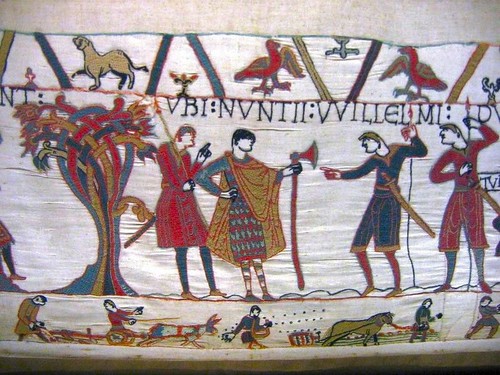 It clearly represents a lot of work, but it wasn’t a work of love. Instead, the general consensus is that it was commissioned by a member of the French clergy and produced by a bunch of English monks, sweating under the lash of their new masters. Perhaps my expectations were too high, but I thought it was going to be one of those breathtaking artistic experiences. It’s not hard to see why nobody does tapestries anymore.
It clearly represents a lot of work, but it wasn’t a work of love. Instead, the general consensus is that it was commissioned by a member of the French clergy and produced by a bunch of English monks, sweating under the lash of their new masters. Perhaps my expectations were too high, but I thought it was going to be one of those breathtaking artistic experiences. It’s not hard to see why nobody does tapestries anymore.
Bayeux is a picturesque little city, somehow completely unscarred by the events of World War II. However, once you’ve seen the cathedral and the tapestry, there’s not much left to do there.
Everyone is familiar with the term “D-Day” but I never thought to ask what the “D” stands for. As it turns out, it’s meaningless – a code letter used by the military to indicate a specific day in a series of events where the date is not fixed. It follows in a series of similarly named days: “A-Day,” “B-Day,” etc., each referring to a specific event that must precede or follow another event. In France, the day when the Allies invaded Normandy to free them from German occupation is known as “Jour J.”We drove along the coast from east to west, starting at Juno beach where Canadian forces landed on June 6, 1944 as part of Operation Overlord, the largest seaborne invasion in world history. The Germans had developed massive defenses along the Normandy coast, which was the largest construction project in the 20th century, extending hundreds of miles along the entire west coast of Europe and along the coast of Norway.Surprisingly little of it is left. There are occasional gun emplacements and bunkers. Some of the guns have been preserved, but mostly all you see are occasional pillboxes and concrete pylons. These ugly remnants of war are surrounded by charming little beach cabanas and summer vacation homes. After all, this is prime waterfront property.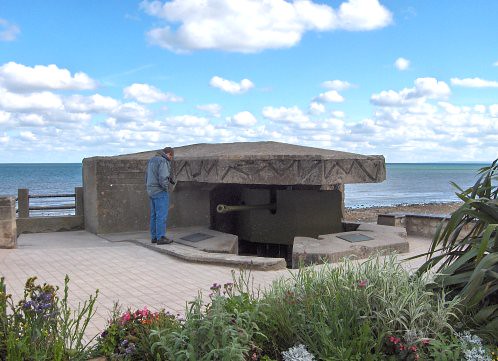 We proceeded from Juno beach to Sword beach. Each of the invasion beaches has a memorial of some kind, and usually a museum commemorating the sacrifices of the forces that landed there. We stopped in one cute little museum that commemorated two events: The Normandy invasion and the 1927 trans-Atlantic flight by Admiral Richard Byrd and 3 crew members to try and claim a $25,000 prize by being the first to cross the Atlantic from New York to Paris. He wound up ditching in the ocean off the Normandy coast, but if you’re interested, there’s a museum that tells the whole story.My daughter, of course, was bored to death by the museum.
We proceeded from Juno beach to Sword beach. Each of the invasion beaches has a memorial of some kind, and usually a museum commemorating the sacrifices of the forces that landed there. We stopped in one cute little museum that commemorated two events: The Normandy invasion and the 1927 trans-Atlantic flight by Admiral Richard Byrd and 3 crew members to try and claim a $25,000 prize by being the first to cross the Atlantic from New York to Paris. He wound up ditching in the ocean off the Normandy coast, but if you’re interested, there’s a museum that tells the whole story.My daughter, of course, was bored to death by the museum.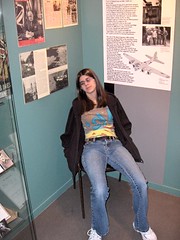 Eventually, we came to the town of Arromanches. There’s a large cliff overlooking the beach, from which you can see the incredible artificial harbor created by the Allies in a matter of days to support the landing. The port cities of Cherbourg, Le Havre, Calais, and others were too heavily defended for a successful seaborne assault, so the Allies had to build their own after taking the beaches in Normandy. They towed pre-built concrete caissons across the channel and dumped them off the coast to act as a breakwater, enabling them to move men, ammunition and machinery to support the invasion until the liberation of Antwerp in September, nearly 3 months later. It’s not intact, but is an impressive sight from the top of that cliff.The sunken caissons sweep in a magnificent arc for thousands of feet. Down on the beach you can see some things that look like bales of hay. Those are caissons, and they're huge.
Eventually, we came to the town of Arromanches. There’s a large cliff overlooking the beach, from which you can see the incredible artificial harbor created by the Allies in a matter of days to support the landing. The port cities of Cherbourg, Le Havre, Calais, and others were too heavily defended for a successful seaborne assault, so the Allies had to build their own after taking the beaches in Normandy. They towed pre-built concrete caissons across the channel and dumped them off the coast to act as a breakwater, enabling them to move men, ammunition and machinery to support the invasion until the liberation of Antwerp in September, nearly 3 months later. It’s not intact, but is an impressive sight from the top of that cliff.The sunken caissons sweep in a magnificent arc for thousands of feet. Down on the beach you can see some things that look like bales of hay. Those are caissons, and they're huge.  There’s a museum in Arromanches that looked interesting, but we we really didn’t have time to see it. However, they did have a bunch of World War II war materiel on display outside, which I found fascinating. This stuff has been lovingly, obsessively preserved, and I found myself wondering where do you go to buy tires for a World War II howitzer?Little shops line the streets of Arromanches, where you can buy World War II uniform reproductions, as well as actual artifacts from the invasion that have been found in the area or dredged up from the ocean bottom. If you want, you can buy an actual German hand grenade (shown at top left in this display case photo), but I couldn’t figure out how to get it home on the airplane.We continued west, eventually arriving at Omaha beach, the site of the bloodiest fighting and the greatest loss of lives in the entire invasion. Over 6,000 Americans lost their lives on this beach. It’s surprisingly pastoral, with people racing sand yachts up and down the beach.Hard to imagine that 60 years earlier, it looked like this:
There’s a museum in Arromanches that looked interesting, but we we really didn’t have time to see it. However, they did have a bunch of World War II war materiel on display outside, which I found fascinating. This stuff has been lovingly, obsessively preserved, and I found myself wondering where do you go to buy tires for a World War II howitzer?Little shops line the streets of Arromanches, where you can buy World War II uniform reproductions, as well as actual artifacts from the invasion that have been found in the area or dredged up from the ocean bottom. If you want, you can buy an actual German hand grenade (shown at top left in this display case photo), but I couldn’t figure out how to get it home on the airplane.We continued west, eventually arriving at Omaha beach, the site of the bloodiest fighting and the greatest loss of lives in the entire invasion. Over 6,000 Americans lost their lives on this beach. It’s surprisingly pastoral, with people racing sand yachts up and down the beach.Hard to imagine that 60 years earlier, it looked like this: On a clifftop overlooking the beach, we visited the American cemetery. There are war cemeteries scattered all over the region, for British, Canadian and American soldiers. There are German cemeteries as well. The American cemetery is beautifully landscaped, and very moving. Thousands of graves lie in orderly rows.
On a clifftop overlooking the beach, we visited the American cemetery. There are war cemeteries scattered all over the region, for British, Canadian and American soldiers. There are German cemeteries as well. The American cemetery is beautifully landscaped, and very moving. Thousands of graves lie in orderly rows. Many of the markers don’t have a name on them, bearing the legend, "Here rests in honored glory a comrade in arms known but to God." Hundreds of such markers stand in mute testimony to the chaos of war.I spend a long time struggling to comprehend what a horrifying nightmare confronted these men 60 years ago, fighting with what we might consider primitive arms today. This neat, peaceful, manicured cemetery situated on a cliff overlooking a beautiful stretch of the Normandy coastline offers no insights into the shocking surge of death that consumed the lives of the soldiers buried here.
Many of the markers don’t have a name on them, bearing the legend, "Here rests in honored glory a comrade in arms known but to God." Hundreds of such markers stand in mute testimony to the chaos of war.I spend a long time struggling to comprehend what a horrifying nightmare confronted these men 60 years ago, fighting with what we might consider primitive arms today. This neat, peaceful, manicured cemetery situated on a cliff overlooking a beautiful stretch of the Normandy coastline offers no insights into the shocking surge of death that consumed the lives of the soldiers buried here.
